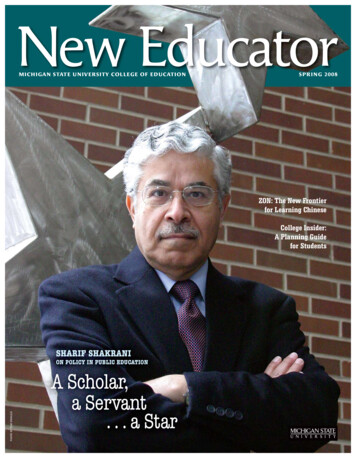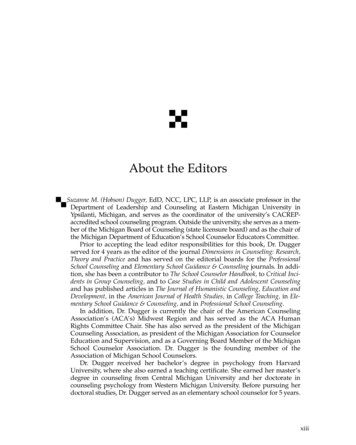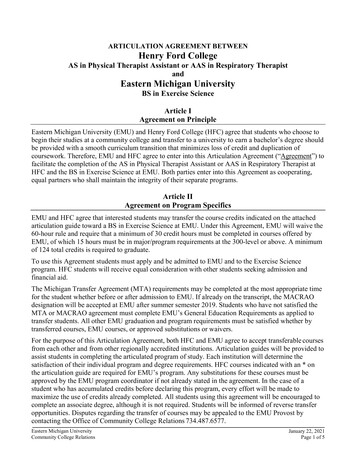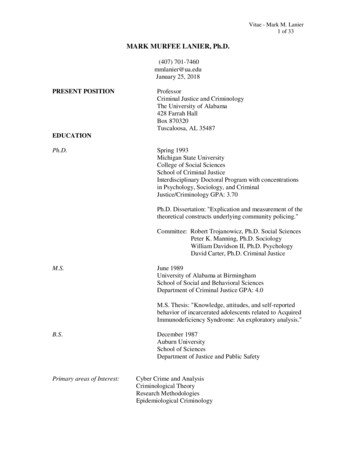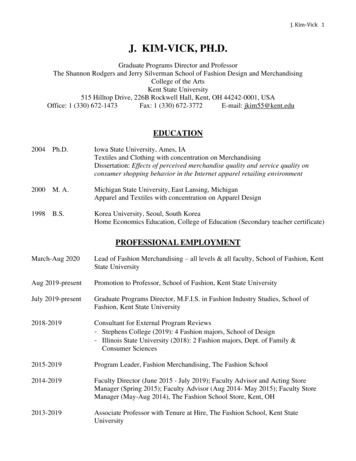
Transcription
Capacity-Building SkillsFor Public OfficialsExtensionBulletinE-1916 (New)October 1985950INFLUENCINGOTHERSDeveloped byDonna Sweeny Extension SpecialistDept. of Resource DevelopmentMichigan State UniversitySeries developed through the courtesy of'Ciation
ContentsI. IntroductionII. Leadership DefinedIII. Leadership as StyleIV. Task or People OrientationV. Goal and Role ExpectationsVI. Interaction Skills For LeadersVII. The Role of the Group MemberVIII. ConclusionSuggested Further ReadingsAPPENDICESA-1 The Angry ClerkA-2 The Citizen ComplaintB T-P Leadership QuestionnaireC Wanted: A Treasurer!D Evaluating Leadership StylesE The Chairperson's DilemmaPage125101114161820212325303135
CAPACITY-BUILDING SKILLSFORPUBLIC OFFICIALSINFLUENCINGOTHERSObjectives of this bulietin are:1. To develop an understanding of themany aspects of leadership.a. as styleb. orientation to task or peoplec. role and goal expectations2. To describe interaction skillsnecessary to leaders3. To discuss the fluidity of the leaderrole and the role of the member ininfluencing the groupWhile the focus of these bulletins isthe public official, the material coveredis appropriate for all Extensionaudiences.
I. IntroductionThe ability to influence others is a major task ofelected officials. Every time officials make their viewsknown to other officials or to citizens they are usinginfluence. When you try to convince others to thinkabout issues your way, support an ordinance of yourchoice, or vote the way you think is best, you are exerting influence on others. Although you may not thinkof it as such, you are using leadership skills each timeyou successfully influence others.It is all too common to believe that you are not aleader unless you occupy a formal leadership position,such as supervisor, director, chairperson, etc.However, many people influence others with successfulleadership skills who may rarely, if ever hold such aformal role. For example, a board member of a unit oflocal government, who is known and respected by manyin the community, may have fully as much influenceas the chairperson of the commission or the supervisorof the board.Clearly, leadership is not limited to the formal position of leader. All of us, at one time or other, influenceothers—individuals as well as groups—by our behavior.When we do this, we are functioning as leaders. If twopeople meet in conversation, the one who first initiatesan interaction is the "leader" at that moment and hasthe responsibility of continuing that interaction, if it isonly to discuss the weather. You don't just let the conversation drop after the greeting. From that limited example to the United Nations in session, for instance,people exert leadership abilities as they meet with andinfluence others. Everyone who is active in local government is a leader, to a different extent. Because this istrue, it is important to understand what leadership isand how it functions.1
In order to explore how local officials can bestdevelop their ability to influence others, it is necessaryto explore several aspects of "leadership." This bulletinwill consider such areas as:1. What is leadership "style"?2. How can a leader know which style is best forhim/her?3. Can you change your style?4. Should a leader give greater attention to the jobat hand or to the interactions between people?5. Should a leader do more "telling" or more"asking"?6. What are goal and role expectations, and how doesknowledge of them benefit a leader?7. What are some interaction skills necessary tothose who would influence and lead others?8. Are those members who do not have official leadership roles important to the organization?9. Is leadership constant in individuals and in groups?10. Do local officials have an obligation to try to improve their leadership skills?II. Leadership DefinedIn the extensive writing which has been done onleadership there are almost as many definitions as thereare writers! Here are some of these definitions:2
"A leader is someone with followers." "Leadership is the activity of influencing people tostrive willingly for group objectives." "Leadership is the process of influencing the activities of an individual or a group in efforts towardgoal achievement in given situations." "Leadership is a learned skill which teaches peopleto help others achieve their potential as individualsand group members." "Leadership is the ability to influence and guideothers toward conclusions or actions beneficial to thetotal group." "Leadership is a dynamic process which varies withthe differing situations, leaders and followers."Think of specific examples of leadership from yourexperience. Ask yourself the following questions: Do all the definitions apply to your experiences inlocal government? Is there one definition in particular that is most validto your experience? How would you define leadership, based on personalexperience?The final definition in the listing above, "leadershipis a dynamic process which varies with the differingsituations, leaders and followers," is one that manyresearchers and observers of leader behavior generallyagree on. Leadership is comprised of many variables,but those variables center largely around the fluidityof particular situations and the individual's ability tomeet those situational needs at crucial times.3
Changes in personnel, in needs of individuals orgroups, or problems to be solved, can all affect thesituation around which the leader emerges and acts.Most people can meet the demands of leadership byincreasing their sensitivities, knowledge or training,when the situation is one that urges them to developand use those attributes of a "leader."Leadership, in itself, may be such that it only benefitsthe particular leader. The leader's behavior or actionsshould aid others in accomplishing their goals.Many times people believe "leaders are born and notmade." They feel that certain rare individuals have particular qualities—such as intelligence, extra energy,"charm"—which cause them to easily function asleaders, acceptable to those searching for a leader orthose who are willing to be led. Many years of research,as well as observation of countless individuals who havefunctioned as leaders, fail to bear out this idea.It is often an excuse for people who do not care toexert themselves enough to assume the burden ofleadership. While certain effective leaders may welldemonstrate some of the qualities or attributesdescribed above, rarely were they "born with them."Rather, they have more often been willing to respondto the needs in a particular situation, and havedeveloped those characteristics in order to help a groupat a particular time.Countless people, who never were perceived as"born leaders," have successfully assumed the responsibilities of leadership for a limited period of time. Then,they have become group members again until (or ifever) there is another situation that causes them to bewilling to function as a leader once more. Other people may respond to a particular situation and help a4
group with their ability to lead, only to find they enjoysuch a role. This causes them to seek other opportunities for leadership. They may eventually be identified by their peers as "leaders" in many situations andover a period of many years.But those people were not "born" as leaders, either.Their abilities were developed by differing sets ofvariables all coming together at times which encouraged them to develop their training, knowledge, sensitivities, organizational skills, or whatever wasnecessary to meet certain situational needs. Withrepeated experiences habit makes those skills easier;also, successful experiences continue to develop confidence. Thus the ability to influence grows and thesepersons are recognized as "leaders" by their peers.Elected officials are, by virtue of their election,recognized as leaders, or potential leaders, by their constituents. They were hardly "born" to be elected officials! So, much of the time, some parts of the processes described above will have been in operation tocause them to become representatives of local government in their communities. Leadership, then, can beseen as a highly situational response to needs or circumstances with which an individual is involved.III. Leadership as StyleA great deal of research and subsequent writing hasbeen done concerning people influencing people asthey come together to run their communities and solvedaily problems. The attention given to leadership"style" has been particularly intensive. There are manyways "style" can be (and has been) described, fromtwo basic styles up to one author's construct whichdelineates twenty-four different aspects of style. While5
those are interesting to consider and certainly havesome value, it is simpler to hold to fewer descriptionswhich can easily be used in daily interactions. Following are two basic styles, and one adjunct style, withwide variations of leadership behavior valuable foreveryday use.A leader has the choice of an Assertive, democraticstyle, an Aggressive, autocratic style or one completelyopposite of the autocratic style which employs a veryminimum of influence.The Assertive style is characterized by a great dealof group involvement. When this style is used, theleader employs behaviors such as the following: diplomacy respect for others attention to needs of associates flexibility honesty straightforwardness empathy patienceThe assertive leader is comfortable with her/himselfand this encourages others to be comfortable (I'm OK,You're OK). The assertive leader tends to look on thepositive side of things and to expect cooperation from,and pleasant interactions with, other board membersor the public. The assertive leader will give others trust6
and the benefit of the doubt when it is sensible to doso.1 The Assertive style uses behavior which is confident, sincere, caring, open and non-judgmental. Assertive leaders know how to really listen, without beingeasily threatened by whatever is said to them. They arewilling to be convinced of new or different views, if theymake sense. An assertive leader uses " I " messagesof honest feelings, as well as "We" messages whichshow inclusion and willingness to work together.While this style offers clear leadership to a group,it also guides and encourages members to share in theresponsibility of decision-making and goal attainmentto benefit the whole group. Of the three leadershipstyles described in this bulletin, the Assertive,democratically-oriented style provides the most effective and successful role model for local officials.The aggressive style is characterized by the following behaviors: strong control domination through authority "telling" more than "asking" holding/using power over people inflexibility manipulation/coercion impatience negative judgments1Refer to "The Angry Clerk" in Appendix A, page 21,for practice in working with this style.7
The aggressive leader often thinks well ofhim/herself, but does not necessarily think well or haverespect for others (I'm OK, You're Not OK). It is notunusual, however, to find Aggressive leaders who putup a noisy, domineering "front" so that others will notrealize that they are basically insecure. They may beinsecure in themselves, personally, and insecure intheir present role as leader. Those who are secure tendto carry their self-satisfaction to a point which causesthem to be unfairly discriminating and judgmental ofother people, ideas, or input which may differ from theirown. Insecure people may be accepting of an Aggressive leader, since the domination makes them feelmore secure. Most people, however, find it difficult towork in what is essentially a "parent-child" atmosphere."Laissez-faire" is the adjunct style mentionedearlier. It is the extreme opposite of the Aggressivestyle, and is characterized by the following behaviors: giving of freedom non-intervention non-judgmental accepting (of most everything)The "laissez-faire" style is essentially non-influentialin that it tends to leave people alone to do as they seefit, to a large extent. It is a style of behavior which issometimes similar to the Passive behavior describedin No. 1 of this series, Extension Bulletin E-1915 "Express Yourself (Without Turning Others Off!)." Theleader virtually abdicates leadership, as such, in theinterests of letting people express themselves, being"totally democratic," or allowing members to "do theirown thing," or other such reasons for allowing8
members great freedom of action. Such a leader maytruly hold democratic values, or he/she may actuallyfeel inept in the leader role and give such freedom inthe hope that members will go ahead on their own anddo what needs to be done.Is there a place for such a leadership style? Perhaps,in an unusual, but possible situation. If, for example,a particular board of local officials contained memberswho hold extremely similar goals and agreement onmethods of working toward those goals; if they are allcreative, self-motivated individuals; if they are able towork well individually, yet come together equably indecision-making; if they are all highly committed to thesuccess of local government and their roles in it, thenthe "laissez-faire" style of leadership may be sufficientto produce desired results. In fact, however, such conditions are very rarely found in all members of a group.When this is the case, the passive, freedom-giving stylemay not provide sufficient leadership to result in goalaccomplishment.Every local official stands to benefit by analyzingher/his style of leader behavior against the criteria provided by these basic models. It is also helpful to identify the style (and from there, the motivation) of thosewith whom they interact on the board, in committees,etc. It is clear that leaders who are positive in their approach, using the Assertive style, expect the best fromothers, are the most apt to find success in influencingothers to the greatest good of local government. If aleader is either too dominating or projects no expectations at all, the results are usually negative. When themore rewarding, productive Assertive style is used, bothleader and members are allowed to grow as individuals9
and to contribute significantly to the whole experienceof the group.2IV. Task Or People OrientationAnother aspect of leader behavior closely allied toleadership style is the leader's orientation either to"task" or "people." Authoritarian, aggressive leadership behavior is typically more concerned with gettingthe task completed, on time and in detail, than with thehuman aspects which are involved. On the other hand,the more democratic, assertive leader is group-orientedand concerned with the people and their relationships.This leader reinforces members' capabilities and helpsthem work through group or individual needs or concerns. While the task-oriented leader may achieve ahigh output of work from the group, this leader is aptto develop low morale through coercion and a general"high-handedness." Such high output is often of shortduration, due to the repressive style of the leader. Inthe long-run, this style causes damage to the organization through the resulting high turnover amongemployees.The people-oriented leader tends to develop highmorale, and—when effective at facilitating group goalsand direction—will also produce a high output. Outputwill be lessened, however, if the people-oriented leaderis not a competent facilitator and allows the group to"wander" in purpose and decision-making.To relate the "task" or "people" orientation to theprevious discussion of style, it is easy to see that the"task" oriented leader is identified with the Aggressive2Refer to "The Citizen Complaint," Appendix A, page 23.10
style, while the assertive leader is "people" oriented.When a people-oriented leader is a poor facilitator, notproviding adequate strength of leadership, she/he couldthen be identified with the "laissez-faire" leaderdescribed earlier.Management studies have repeatedly shown that effective leaders find a balance between the extremesof "task" and "people" orientations. This balance getsthe job done, sensitive to the human needs and relationships involved in the particular group. As the needs,the situation, the leaders and the members change, thebalance will also need to change from time to time tomaintain appropriate leader behavior. (This "balance"is shown as the "Mixed Style" on the evaluation toolincluded in Appendix B.)3V. Goal and Role ExpectationsResearch and observed practice in the leadershiparea indicates another element which contributes tothe success or failure of a leader. Successful leadersare able to make goal and role expectations very clearfor themselves and their group members. They maketheir goals evident, as well as how they expect to accomplish them. They also help the group understandits own sense of goals and roles for the leader, and howit expects she/he to accomplish them. When this isdone, the "boundaries" are established. If either thegroup or leader deviates too far, it will be noticed andcan be discussed and adjusted. If there is significantcontradiction between roles and goals as seen byleaders and members, it is easily noted and can bediscussed and adjusted.3Refer to "T-P Leadership Questionnaire," Appendix B,page 25.11
Much conflict and mistrust between people is causedby differing expectations. This is true in personal relationships, in public meetings and in the range of humanactivities. The public official will find it advantageousto be open in describing what is intended in his/her role,and how it is intended to be carried out in dealing withthe board and with the public. Even a general pictureof intentions (goals) and expected behavior (roles) fromthe board will help keep communication open and anatmosphere of productive compatibility.For example, incumbents and newly elected officialscan use goal and role expectations advantageously.Constituents affected by these new leaders can alsobenefit. Before proposing an individual for an importantrole, discuss the behavioral characteristics needed.What skills and behavior do we want from that personand what results do we hope to gain?The next step is to acquaint the candidate with thebehavioral role and goal expectation of constituents andpeers. The candidate who feels he/she can work withinthat cluster of expectations would be a valid candidatefor the position. (Note: this agreeability doesn't haveto be a "perfect fit," by any means. It is important thatthe expectations of the group match the candidate'sown value system and role/goal perceptions so thatshe/he can make progress in the role.) The final stepin this process is for the candidate to discuss his/herrole and goal expectations. In this way, incumbents,peers and others can be certain there is understandingand a reasonable degree of acceptance.This optimum use of role/goal expectations is notalways possible. The process cannot normally be usedin local governmental elections. There may be times,however, when a candidate can be sought to meet aneed or particular situation. When a vacancy must be12
filled, there is usually enough time available to attempta compatible "match." The steps described previously could be used to some extent in a mutual "screening" process. If it further verified the candidate's potential, and if he/she is willing to run, the actual declaration of candidacy could follow.The process described here can be valuable for hiring staff people to run the office, also. It is a good wayto communicate about the job, what it involves, and thebehavior and skills everyone agrees are needed to getit done. Some level of mutual understanding based onopenly-discussed expectations leads to compatible relations and success in fulfilling the role.While any leader can develop new, more effectivebehaviors, it may be somewhat difficult for some people. In those cases, it might be better for the leader tochange his/her expectations of others instead of changing his/her style. If the leader changes the "interactionenvironment" through adjusting key expectations, theattempts to change her/his behavior may not benecessary. This may be done by delegating certainresponsibilities to others, developing a stronger committee system, using an advisory council, changing orrestructuring certain procedures. The leader must lookat the situation and, (a) determine where a change inexpectations of the group can alter the interaction environment, so as to, (b) allow the conditions necessaryto goal fulfillment in a manner compatible with theleader's own style.44Refer to "Wanted: A Treasurer!" Appendix C, page 30.13
VI. Interaction Skills For LeadersLeadership—or the ability to influence others—canbe viewed as a composite of learnable skills by whoseuse the efforts of individuals and sub-groups arecoalesced and enabled to work amenably toward common goals. The use of these skills varies with needsof particular situations at different times. A leader mustbe able and willing to use such behaviors as thefollowing: To accept and clarify another's feelings withoutthreatA high, unflappable threat level is a valuablecharacteristic for a leader. If a leader is easilythreatened, group members will become conflictiveor frustrated with the leader, either of which will inhibit the group's accomplishment of purposes. To aid the group's insights into its feelings andattitudesA leader must be able to see the broad picture ofwhat is occurring in the group and relate it back tothe group for total understanding. To relate emotions or feelings to the demands ofthe present situation.When an issue becomes emotional, people tend toget off on their own concerns, irrespective of theirrelevance. The leader needs to see these forays asthey develop, and lead the offenders back on target. To state all sides of a controversy fairly.It is improper for the leader to allow or present onlythe side of a controversy which reflects his/her ownviews. Whether or not she/he agrees with variousviews, it is necessary to bring them all out for groupunderstanding and discussion.14
To summarize group discussion.It is important that the leader sees the whole picture,ties up loose ends, and brings themes or issuestogether in a succinct, integrated manner. To bring a group to a point for decision-makingwithout threat.This is an extension of the above behavior carriedto conclusion after a prolonged meeting ordiscussion. To recognize and interpret forces operating in thegroup.An effective leader has all antennae working at alltimes! He/she must be easily verbal and constantlyand fairly interpret the group back to itself. To sense and be ready to act on the developmentof tension.Again, great sensitivity and awareness of each groupmember is necessary. To be aware of the body language and othersignals used by members. To coordinate the questions and steps the groupmust consider in its decision-making.Using the broad view, restate in a way both accurateand satisfying to the group. To recognize and accept conflict as a normal partof group interaction.A wise leader knows that issue-oriented conflict canbe beneficial to a group, while "personality" conflictcan destroy a group.15
To encourage others to gain experience in, andlearn skills of, leadership.Good leaders who put the needs of the group beforetheir personal needs will always encourage thedevelopment of new leadership.Public officials who recognize and accept the valueof these skills and learn to use them in their leadershiproles, will find themselves increasingly able to influenceothers in ways that will aid in developing truly effective local government.5VII. The Role of the Group MemberOften, people want to run for supervisor or treasurer,or some other perceived "influential" role so that theymay have and use power over others. Certainly, suchroles allow opportunities for using influence (or power);but roles not designated a "leader" include those opportunities, too. Strong, supportive group members whoare good communicators can be as influential as thosein designated leader roles. Leaders cannot do it allalone. They need the verbal and emotional support oftheir group members.Support is needed from fellow officials, staff andothers who are in agreement with their positions.Without that support, many potential and proven leadershave faded into obscurity, to everyone's loss. On theother hand, it is not unusual to find citizens who exertdefinite, long-lasting influence on local governmentwithout ever seeking a formal leadership role. Influence,then, can be exercised through the use of good communication skills, whether or not formalized leadershiproles are involved.5Refer to "Evaluating Leadership Skills," Appendix D,page 31.16
The ideal role of the group member is one of positivesupport for the chosen leader, whenever the membercan honestly agree with the stand he/she takes. Whena member cannot agree with the leader, disagreementshould be expressed openly with rationale provided asthe basis for the disagreement. Group members whouse influence negatively through verbal "sniping" atthe leader do everyone a disservice, includingthemselves. They can better influence the group to adiffering view by presenting verified information, orrecognized successful experience, rather than usingnegative emotions in a collusion against the leaders.Roles of "leader" and "supporter" interchange manytimes in a typical meeting, as was suggested early inthis bulletin. The chairperson may relinquish his/herleader role many times in the ebb and flow of continueddiscussions. The role of leader switches hands naturallyas group discussion flows back and forth. Group interaction and results would suffer if such unplanned"leading" did not occur in the meeting.A contributing, committed member of a board willbe able to influence others. He/she will be able to leadwithout needing the formal role designation of leader.Knowing this, members can concentrate their effortson making contributions to the group without worryingabout proper labels. This also makes it easier for thoseleaving office. They know that they can still continueto hold a valued role in their local governmental affairs,if they choose to.In the leader role, the skills of facilitation and coordination are most used. In the supporter role, skills ofreinforcement and compromise are seen more frequently. You need to determine which skills you are bestwith and either hold to using those, in their appropriate17
roles, or be willing to practice learning the remainingskills until you can practice them as well.6VIII. ConclusionThe ability to influence others has many facets. Thequality called "leadership" is not static and unchangeable, but depends on a multitude of particularabilities, circumstances, needs and individuals. Leadership, then, is a fluid state in which individuals emergeat times with certain skills to meet certain situationsand help people solve their problems. At times, peoplewho find they can function effectively as leaders maycontinue in various dominant roles. Others choose notto continue in roles of prominence, but prefer to returnto the group member role.People generally respond most favorably to ademocratically-oriented leadership style rather than acontrolling, autocratic style. Effective leaders worktoward accomplishing group goals and are still sensitiveto human needs and interactions of individuals in thegroup. Effective leaders are effective communicators.They are open and clear as they deal with their groupmembers, and listen attentively and respond appropriately. Leaders who successfully influence others arecareful to clarify mutual goal and role expectationsbefore committing themselves to working at length witha particular group, assuming time and circumstancesallow such pre-planning.The old saying, "It isn't what you do, it's how youdo it," was never truer than in the arena of behaviorcalled "leadership." A successful leader truly leads and'Refer to "The Chairperson's Dilemma," Appendix E,page 35.18
doesn't push. Such a leader asks, rather than tells; expects cooperation and intelligence from members;shows basic respect for others; is willing to learn fromothers and admit to mistakes. An effective leader is confident without being egotistical; is strong withoutneeding to dominate; knows that persuasion is a morehonest and effective way to succeed with people thanis force or manipulation.Being willing to look seriously inward at your ownmanner of "leadership" is the first necessary step inattempting to become more effective as a local policymaker. We don't have to "grow like Topsy." We canchange behavior, expectations and the environmentaround us to the point that we emerge as more effective individuals. Surely, every really dedicated local official has a sincere commitment to the best possiblefulfillment of his/her role. It is well worth the selfexamination and discipline needed to make changesand grow.And remember to look behind you from time to timeas you attempt to become a real leader—because aleader is someone with followers!19
SUGGESTED FURTHER READINGSWarren Bennis. Changing Organizations. McGraw-HillBook Co.Amitai Etzioni. Complex Organizations. The Free Press.Thomas Harris. I'm Ok- You're Ok: A Practical Guideto Transactional Analysis. Harper and Row.Chris Argyris. Interpersonal Competence and Organizational Effectiveness. Dorsey Press and Richard D. Irwin, Inc.V.H. Vroom. Leadership and Decision-Making. University of Pittsburgh Press.Douglas McGregor. Leadership and Motivation. MITPress.Paul Hersey and Kenneth Blanchard. Management ofOrganizational Behavior. Prentice-Hall, Inc.L.B. Hart. Moving Up!: Women and Leadership.AMACOM.Peter Drucker. The Practice of Management. Harperand Row.Abraham Maslow. Toward a Psychology of Being. VanNostrand Co., Inc.20
APPENDICESAppe
INFLUENCING OTHERS Objectives of this bulietin are: 1. To develop an understanding of the many aspects of leadership. a. as style b. orientation to task or people c. role and goal expectations 2. To describe interaction skills necessary to leaders 3. To discuss the fluidity of the leader role and the role of the member in influencing the group


